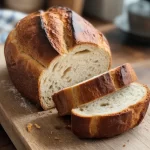I finally mastered my mom’s Chewy French Bread, made with only five ingredients and one surprising technique that makes it reliably foolproof.

I can’t stop thinking about this Chewy French Bread, the five ingredient loaf my mom perfected. It’s stupid simple, uses bread flour and active dry yeast, and folds into everything from soup to sandwich duty.
I like how the crust fights back a little while the inside stays pull-apart chewy, you swear you can’t make it at home until you do. It’s not fancy, but it becomes your go-to Good Bread For Soup, the one you brag about and then secretly hide the last piece.
You’ll want to make it again and again, even when you tell yourself you’ll save it for guests.
Ingredients

- Bread flour: High gluten flour, adds chew and strong structure, more protein then all purpose.
- Water: Hydrates flour and controls dough feel, warm water helps yeast wake up faster.
- Active dry yeast: Tiny live cells that produce gas, give lift and subtle fermentation flavour.
- Salt: Balances taste and tightens gluten, but too much will slow the rise.
- Sugar: Feeds yeast for quicker rise, adds gentle sweetness and helps crust brown.
Ingredient Quantities
- 3 cups bread flour
- 1 1/4 cups warm water (about 110°F)
- 2 1/4 tsp active dry yeast 1 packet
- 1 1/2 tsp salt
- 1 tsp sugar
How to Make this
1. Pour 1 1/4 cups warm water (about 110°F) into a bowl, stir in 1 tsp sugar until dissolved, sprinkle 2 1/4 tsp active dry yeast over the top and let sit 5 to 10 minutes until foamy.
2. In a large bowl mix 3 cups bread flour with 1 1/2 tsp salt, make a well and pour in the foamy yeast water.
3. Stir with a wooden spoon or dough scraper until a shaggy, sticky dough forms, scraping down the sides so no dry flour remains.
4. Knead or fold: if using a stand mixer, knead 4 to 6 minutes with the dough hook until smooth and slightly sticky. By hand, wet your hands and knead 8 to 10 minutes, or do 4 sets of stretch-and-folds every 10 minutes. The dough will be tacky, thats normal.
5. Lightly oil a clean bowl, transfer the dough, cover with plastic or a towel and let rise in a warm spot until doubled, about 1 to 1 1/2 hours. Tip: put the bowl in a turned-off oven with the light on for steady warmth.
6. Turn the dough onto a well floured surface, gently press out the air, fold into a rough baguette or oblong loaf shape. Wet your hands if it gets too sticky, don’t add too much flour.
7. Place shaped loaf seam side down on a parchment lined baking sheet or peel, cover loosely and let proof until puffy about 45 to 60 minutes. Meanwhile preheat oven to 450°F with a baking stone or heavy sheet inside and an empty metal pan on the lower rack.
8. Just before baking, make 3 or 4 quick diagonal slashes across the top with a sharp knife or lame, then slide the loaf onto the hot stone or sheet. Pour 1 cup hot water into the lower pan to create steam, or drop in a few ice cubes for a burst of steam.
9. Bake 20 to 30 minutes until the crust is deep golden and the loaf sounds hollow when tapped, or until internal temp reaches about 200 to 210°F. Rotate once if your oven bakes unevenly.
10. Cool on a wire rack at least 20 to 30 minutes before slicing so the crumb sets, then enjoy with soup, butter, or your favorite sandwich fillings.
Equipment Needed
1. Large mixing bowl (for dissolving yeast and letting the dough rise), warm it a bit with hot water then dump it out so the rise is steady.
2. Measuring cups and spoons, get them accurate for flour, water, salt and sugar.
3. Instant read thermometer, makes sure your water is about 110°F and the loaf hits ~200 to 210°F.
4. Wooden spoon or dough scraper to mix the shaggy dough, then a bench scraper to handle and shape it.
5. Stand mixer with dough hook or just clean hands if youre kneading by hand.
6. Well floured work surface or pastry board for shaping the loaf.
7. Baking stone or heavy rimmed baking sheet, plus a second empty metal pan to create steam.
8. Parchment paper or a peel for sliding the loaf onto the hot stone, plus a sharp serrated knife or lame for scoring.
9. Oven mitts and a wire cooling rack so the loaf can cool properly before slicing.
FAQ
Chewy French Bread Recipe Substitutions and Variations
- Bread flour: use all-purpose flour plus 1 tablespoon vital wheat gluten per cup to restore chew, or just AP flour 1:1 if you dont have gluten, expect a softer, slightly less chewy loaf.
- Active dry yeast: swap for instant yeast 1:1 (no proofing needed), or use about 1 cup active sourdough starter and skip the packet yeast but plan much longer, cooler rises and a tangier flavor.
- Warm water (about 110°F): substitute warm milk 1:1 for a richer, softer crumb, or use lukewarm beer or whey for extra flavor; keep liquid temp around 100-115°F so you dont kill the yeast.
- Sugar: replace with honey or maple syrup at about 3/4 the volume (eg 1 tsp sugar = 3/4 tsp honey) and slightly reduce other liquids, or use malt syrup for a more authentic bread taste.
Pro Tips
1) let the yeast really proof. if the water feels much hotter than warm or the yeast doesnt go foamy in 10 minutes, chuck it and start over. too-hot water will kill yeast, too-cold will make it slow, so use a thermometer or test on your wrist.
2) resist adding a ton of flour when the dough is sticky. wet your hands, do gentle folds or stretch and folds instead of heavy kneading, and a light dusting only if it really sticks. overflouring makes a dense crumb.
3) steam matters for a crunchy crust. preheat a stone or heavy sheet and toss hot water or ice cubes into a metal pan in the oven right when you put the loaf in, then remove the pan after 10 to 15 minutes for good crust color and oven spring.
4) try a slow cold ferment for more flavor. after the first rise pop the dough in the fridge overnight, then shape and proof next day. it takes longer but the loaf will taste deeper and more complex, worth the wait.

Chewy French Bread Recipe
I finally mastered my mom's Chewy French Bread, made with only five ingredients and one surprising technique that makes it reliably foolproof.
8
servings
168
kcal
Equipment: 1. Large mixing bowl (for dissolving yeast and letting the dough rise), warm it a bit with hot water then dump it out so the rise is steady.
2. Measuring cups and spoons, get them accurate for flour, water, salt and sugar.
3. Instant read thermometer, makes sure your water is about 110°F and the loaf hits ~200 to 210°F.
4. Wooden spoon or dough scraper to mix the shaggy dough, then a bench scraper to handle and shape it.
5. Stand mixer with dough hook or just clean hands if youre kneading by hand.
6. Well floured work surface or pastry board for shaping the loaf.
7. Baking stone or heavy rimmed baking sheet, plus a second empty metal pan to create steam.
8. Parchment paper or a peel for sliding the loaf onto the hot stone, plus a sharp serrated knife or lame for scoring.
9. Oven mitts and a wire cooling rack so the loaf can cool properly before slicing.
Ingredients
-
3 cups bread flour
-
1 1/4 cups warm water (about 110°F)
-
2 1/4 tsp active dry yeast 1 packet
-
1 1/2 tsp salt
-
1 tsp sugar
Directions
- Pour 1 1/4 cups warm water (about 110°F) into a bowl, stir in 1 tsp sugar until dissolved, sprinkle 2 1/4 tsp active dry yeast over the top and let sit 5 to 10 minutes until foamy.
- In a large bowl mix 3 cups bread flour with 1 1/2 tsp salt, make a well and pour in the foamy yeast water.
- Stir with a wooden spoon or dough scraper until a shaggy, sticky dough forms, scraping down the sides so no dry flour remains.
- Knead or fold: if using a stand mixer, knead 4 to 6 minutes with the dough hook until smooth and slightly sticky. By hand, wet your hands and knead 8 to 10 minutes, or do 4 sets of stretch-and-folds every 10 minutes. The dough will be tacky, thats normal.
- Lightly oil a clean bowl, transfer the dough, cover with plastic or a towel and let rise in a warm spot until doubled, about 1 to 1 1/2 hours. Tip: put the bowl in a turned-off oven with the light on for steady warmth.
- Turn the dough onto a well floured surface, gently press out the air, fold into a rough baguette or oblong loaf shape. Wet your hands if it gets too sticky, don’t add too much flour.
- Place shaped loaf seam side down on a parchment lined baking sheet or peel, cover loosely and let proof until puffy about 45 to 60 minutes. Meanwhile preheat oven to 450°F with a baking stone or heavy sheet inside and an empty metal pan on the lower rack.
- Just before baking, make 3 or 4 quick diagonal slashes across the top with a sharp knife or lame, then slide the loaf onto the hot stone or sheet. Pour 1 cup hot water into the lower pan to create steam, or drop in a few ice cubes for a burst of steam.
- Bake 20 to 30 minutes until the crust is deep golden and the loaf sounds hollow when tapped, or until internal temp reaches about 200 to 210°F. Rotate once if your oven bakes unevenly.
- Cool on a wire rack at least 20 to 30 minutes before slicing so the crumb sets, then enjoy with soup, butter, or your favorite sandwich fillings.
Notes
- Below you’ll find my best estimate of this recipe’s nutrition facts. Treat the numbers as a guide rather than a rule—great food should nourish both body and spirit. Figures are approximate, and the website owner assumes no liability for any inaccuracies in this recipe.
Nutrition Facts
- Serving Size: 85g
- Total number of serves: 8
- Calories: 168kcal
- Fat: 0.7g
- Saturated Fat: 0.2g
- Trans Fat: 0g
- Polyunsaturated: 0.2g
- Monounsaturated: 0.3g
- Cholesterol: 0mg
- Sodium: 445mg
- Potassium: 48mg
- Carbohydrates: 34.7g
- Fiber: 1.5g
- Sugar: 0.5g
- Protein: 4.8g
- Vitamin A: 0IU
- Vitamin C: 0mg
- Calcium: 7mg
- Iron: 1.6mg
















